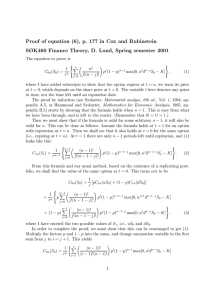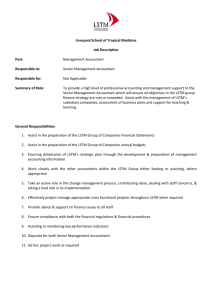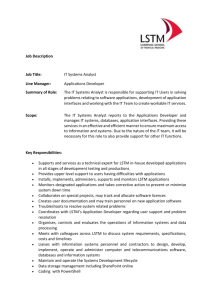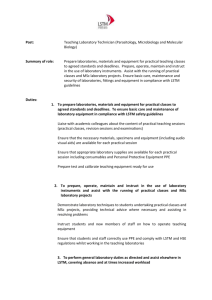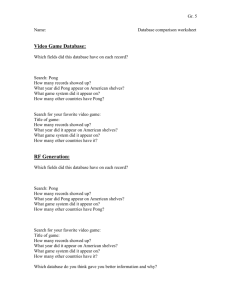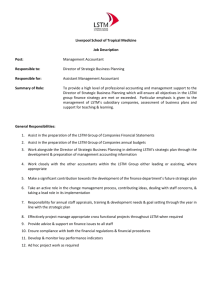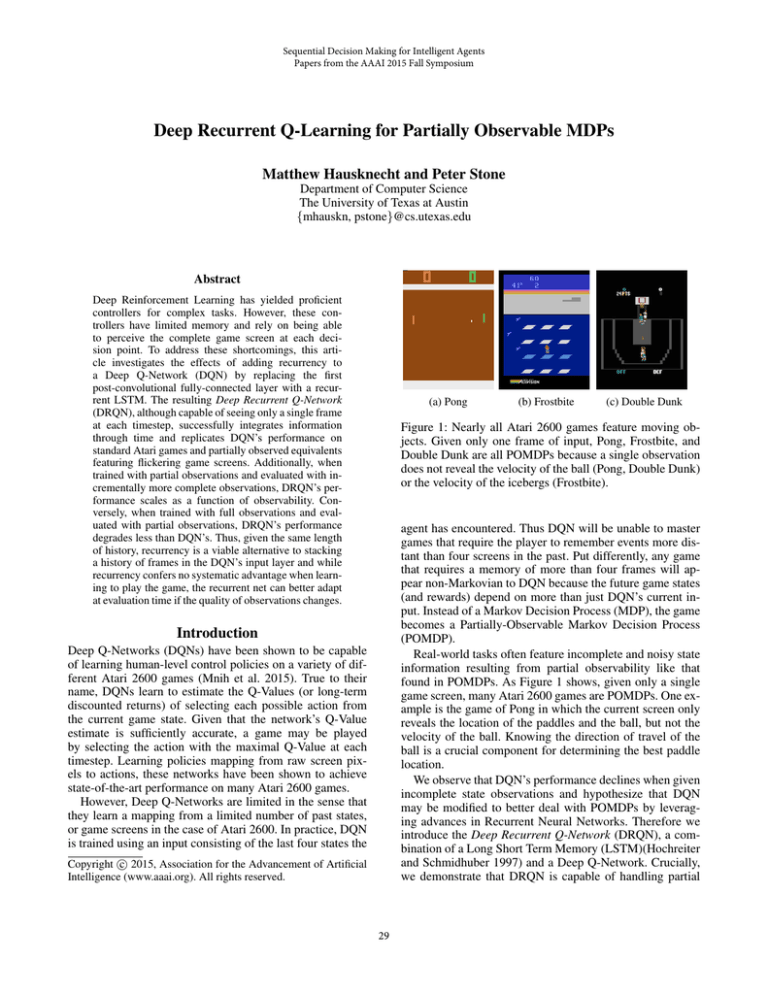
Sequential Decision Making for Intelligent Agents
Papers from the AAAI 2015 Fall Symposium
Deep Recurrent Q-Learning for Partially Observable MDPs
Matthew Hausknecht and Peter Stone
Department of Computer Science
The University of Texas at Austin
{mhauskn, pstone}@cs.utexas.edu
Abstract
Deep Reinforcement Learning has yielded proficient
controllers for complex tasks. However, these controllers have limited memory and rely on being able
to perceive the complete game screen at each decision point. To address these shortcomings, this article investigates the effects of adding recurrency to
a Deep Q-Network (DQN) by replacing the first
post-convolutional fully-connected layer with a recurrent LSTM. The resulting Deep Recurrent Q-Network
(DRQN), although capable of seeing only a single frame
at each timestep, successfully integrates information
through time and replicates DQN’s performance on
standard Atari games and partially observed equivalents
featuring flickering game screens. Additionally, when
trained with partial observations and evaluated with incrementally more complete observations, DRQN’s performance scales as a function of observability. Conversely, when trained with full observations and evaluated with partial observations, DRQN’s performance
degrades less than DQN’s. Thus, given the same length
of history, recurrency is a viable alternative to stacking
a history of frames in the DQN’s input layer and while
recurrency confers no systematic advantage when learning to play the game, the recurrent net can better adapt
at evaluation time if the quality of observations changes.
(a) Pong
(b) Frostbite
(c) Double Dunk
Figure 1: Nearly all Atari 2600 games feature moving objects. Given only one frame of input, Pong, Frostbite, and
Double Dunk are all POMDPs because a single observation
does not reveal the velocity of the ball (Pong, Double Dunk)
or the velocity of the icebergs (Frostbite).
agent has encountered. Thus DQN will be unable to master
games that require the player to remember events more distant than four screens in the past. Put differently, any game
that requires a memory of more than four frames will appear non-Markovian to DQN because the future game states
(and rewards) depend on more than just DQN’s current input. Instead of a Markov Decision Process (MDP), the game
becomes a Partially-Observable Markov Decision Process
(POMDP).
Real-world tasks often feature incomplete and noisy state
information resulting from partial observability like that
found in POMDPs. As Figure 1 shows, given only a single
game screen, many Atari 2600 games are POMDPs. One example is the game of Pong in which the current screen only
reveals the location of the paddles and the ball, but not the
velocity of the ball. Knowing the direction of travel of the
ball is a crucial component for determining the best paddle
location.
We observe that DQN’s performance declines when given
incomplete state observations and hypothesize that DQN
may be modified to better deal with POMDPs by leveraging advances in Recurrent Neural Networks. Therefore we
introduce the Deep Recurrent Q-Network (DRQN), a combination of a Long Short Term Memory (LSTM)(Hochreiter
and Schmidhuber 1997) and a Deep Q-Network. Crucially,
we demonstrate that DRQN is capable of handling partial
Introduction
Deep Q-Networks (DQNs) have been shown to be capable
of learning human-level control policies on a variety of different Atari 2600 games (Mnih et al. 2015). True to their
name, DQNs learn to estimate the Q-Values (or long-term
discounted returns) of selecting each possible action from
the current game state. Given that the network’s Q-Value
estimate is sufficiently accurate, a game may be played
by selecting the action with the maximal Q-Value at each
timestep. Learning policies mapping from raw screen pixels to actions, these networks have been shown to achieve
state-of-the-art performance on many Atari 2600 games.
However, Deep Q-Networks are limited in the sense that
they learn a mapping from a limited number of past states,
or game screens in the case of Atari 2600. In practice, DQN
is trained using an input consisting of the last four states the
Copyright c 2015, Association for the Advancement of Artificial
Intelligence (www.aaai.org). All rights reserved.
29
observability, and that recurrency confers benefits when the
quality of observations change during evaluation time.
training dataset; the ever-changing nature of D may require
certain parameters start changing again after having reached
a seeming fixed point.
Specifically, at each training iteration i, an experience
et = (st , at , rt , st+1 ) is sampled uniformly from the replay
memory D. The loss of the network is determined as follows:
Deep Q-Learning
Reinforcement Learning (Sutton and Barto 1998) is concerned with learning control policies for agents interacting
with unknown environments. Such an environment is often
formalized as a Markov Decision Process (MDP) which is
completely described by a 4-tuple (S, A, P, R). At each
timestep t an agent interacting with the MDP observes a
state st 2 S, and chooses an action at 2 A which determines the reward rt ⇠ R(st , at ) and next state st+1 ⇠
P(st , at ).
Q-Learning (Watkins and Dayan 1992) estimates the
value of executing an action from a given state. Such value
estimates are referred to as state action values, or sometimes
simply Q-values. Q-values are learned iteratively by updating the current Q-value estimate towards the observed reward and estimated utility of the resulting state s0 :
Q(s, a) = Q(s, a) + ↵ r + max
Q(s0 , a0 )
0
a
Li (✓i ) = E(s,a,r,s0 )⇠D
a
2
Q(s, a; ✓i )
⌘2
(4)
Partial Observability
In real world environments it’s rare that the full state of the
system can be provided to the agent or even determined. In
other words, the Markov property rarely holds in real world
environments. A Partially Observable Markov Decision Process (POMDP) better captures the dynamics of many realworld environments by explicitly acknowledging that the
sensations received by the agent are only partial glimpses
of the underlying system state. Formally a POMDP can be
described as a 6-tuple (S, A, P, R, ⌦, O). S, A, P, R are
the states, actions, transitions, and rewards as before, except
now the agent is no longer privy to the true system state
and instead receives an observation o 2 ⌦. This observation is generated from the underlying system state according to the probability distribution o ⇠ O(s). Vanilla Deep
Q-Learning has no explicit mechanisms for deciphering the
underlying state of the POMDP and is only effective if the
observations are reflective of underlying system states. In
the general case, estimating a Q-value from an observation
can be arbitrarily bad since Q(o, a|✓) 6= Q(s, a|✓).
Our experiments show that adding recurrency to Deep QLearning allows the Q-network network to better estimate
the underlying system state, narrowing the gap between
Q(o, a|✓) and Q(s, a|✓). Stated differently, recurrent deep
Q-networks can better approximate actual Q-values from sequences of observations, leading to better policies in partially observed environments.
Q(s, a) (1)
Q(s, a|✓i )
yi
where yi = r + maxa0 Q̂(s0 , a0 ; ✓ ) is the stale update
target given by the target network Q̂. Updates performed in
this manner have been empirically shown to be tractable and
stable (Mnih et al. 2015).
Many challenging domains such as Atari games feature
far too many unique states to maintain a separate estimate
for each S ⇥ A. Instead a model is used to approximate
the Q-values (Mnih et al. 2015). In the case of Deep QLearning, the model is a neural network parameterized by
weights and biases collectively denoted as ✓. Q-values are
estimated online by querying the output nodes of the network after performing a forward pass given a state input.
Such Q-values are denoted Q(s, a|✓). Instead of updating individual Q-values, updates are now made to the parameters
of the network to minimize a differentiable loss function:
L(s, a|✓i ) ⇡ r + max Q(s0 , a|✓i )
⇣
(2)
✓i+1 = ✓i + ↵r✓ L(✓i )
(3)
Since |✓| ⌧ |S ⇥ A|, the neural network model naturally generalizes beyond the states and actions it has been
trained on. However, because the same network is both generating the next state target Q-values and updating the current Q-values, updates can adversely affect other Q-value
estimates, leading to oscillatory performance or even divergence (Tsitsiklis and Roy 1997). Deep Q-Learning uses
three techniques to restore learning stability: First, experiences et = (st , at , rt , st+1 ) are recorded in a replay memory D and then sampled uniformly at training time. Second,
a separate, target network Q̂ provides stale update targets to
the main network. The target network serves to partially decouple the feedback resulting from the network generating
its own targets. Q̂ is identical to the main network except its
parameters ✓ are updated to match ✓ every 10,000 iterations. Finally, an adaptive learning rate method such as RMSProp (Tieleman and Hinton 2012) or ADADELTA (Zeiler
2012) maintains a per-parameter learning rate ↵, and adjusts
↵ according to the history of gradient updates to that parameter. This step serves to compensate for the lack of a fixed
DRQN Architecture
Depicted in Figure 2, the architecture of DRQN replaces
DQN’s first fully connected layer with a Long Short Term
Memory (Hochreiter and Schmidhuber 1997). For input, the
recurrent network takes a single 84⇥84 preprocessed image,
instead of the last four images required by DQN. The first
hidden layer convolves 32 8 ⇥ 8 filters with stride 4 across
the input image and applies a rectifier nonlinearity. The second hidden layer convolves 64 4 ⇥ 4 filters with stride 2,
again followed by a rectifier nonlinearity. The third hidden
layer convolves 64 3 ⇥ 3 filters with stride 1, followed by
a rectifier. Convolutional outputs are fed to the fully connected LSTM layer. Finally, a fully connected linear layer
outputs a Q-Value for each possible action. We settled on
30
Q-Values
...
18
LSTM
Random updates better adhere to the policy of randomly
sampling experience, but, as a consequence, the LSTM’s
hidden state must be zeroed at the start of each update. Zeroing the hidden state makes it harder for the LSTM to learn
functions that span longer time scales than the number of
timesteps reached by back propagation through time.
Experiments indicate that both types of updates are viable and yield convergent policies with similar performance
across a set of games. Therefore, to limit complexity, all results herein use the randomized update strategy. We expect
that all presented results would generalize to the case of sequential updates.
Having addressed the architecture and updating of a Deep
Recurrent Q-Network, we now show how it performs on domains featuring partial observability.
512
Conv3
64-filters
3 3
Stride 1
64
7
7
Conv2
64-filters
4 4
Stride 2
64
9
Conv1
9
32-filters
8 8
Stride 4
32
Atari Games: MDP or POMDP?
20
20
The state of an Atari 2600 game is fully described by the
128 bytes of console RAM. Humans and agents, however,
observe only the console-generated game screens. For many
games, a single game screen is insufficient to determine the
state of the system. DQN infers the full state of an Atari
game by expanding the state representation to encompass
the last four game screens. Many games that were previously
POMDPs now become MDPs. Of the 49 games investigated
by (Mnih et al. 2015), the authors were unable to identify
any that were partially observable given the last four frames
of input.1 In order to introduce partial observability to Atari
games without reducing the number of input frames given
to DQN, we explore a particular modification to the popular
game of Pong.
1
84
84
Figure 2: DRQN convolves three times over a single-channel
image of the game screen. The resulting activations are
processed through time by an LSTM layer. The last two
timesteps are shown here. LSTM outputs become Q-Values
after passing through a fully-connected layer. Convolutional
filters are depicted by rectangular sub-boxes with pointed
tops.
Flickering Pong POMDP
this architecture after experimenting with several variations;
see Appendix A for details.
We introduce the Flickering Pong POMDP - a modification
to the classic game of Pong such that at each timestep, the
screen is either fully revealed or fully obscured with probability p = 0.5. Obscuring frames in this manner probabilistically induces an incomplete memory of observations needed
for Pong to become a POMDP.
In order to succeed at the game of Flickering Pong, it is
necessary to integrate information across frames to estimate
relevant variables such as the location and velocity of the
ball and the location of the paddle. Since half of the frames
are obscured in expectation, a successful player must be robust to the possibility of several potentially contiguous obscured inputs.
We train 3 types of networks to play Flickering Pong: the
recurrent 1-frame DRQN, a standard 4-frame DQN, and an
augmented 10-frame DQN. As Figure 4a indicates, providing more frames to DQN improves performance. Nevertheless, even with 10 frames of history, DQN still struggles to
achieve positive scores.
Perhaps the most important opportunity presented by a
history of game screens is the ability to convolutionally detect object velocity. Figure 3 visualizes the game screens
Stable Recurrent Updates
Updating a recurrent, convolutional network requires each
backward pass to contain many time-steps of game screens
and target values. Additionally, the LSTM’s initial hidden
state may either be zeroed or carried forward from its previous values. We consider two types of updates:
Bootstrapped Sequential Updates: Episodes are selected randomly from the replay memory and updates begin at the beginning of the episode and proceed forward
through time to the conclusion of the episode. The targets
at each timestep are generated from the target Q-network,
Q̂. The RNN’s hidden state is carried forward throughout
the episode.
Bootstrapped Random Updates: Episodes are selected
randomly from the replay memory and updates begin at random points in the episode and proceed for only unroll iterations timesteps (e.g. one backward call). The targets at each
timestep are generated from the target Q-network, Q̂. The
RNN’s initial state is zeroed at the start of the update.
Sequential updates have the advantage of carrying the
LSTM’s hidden state forward from the beginning of the
episode. However, by sampling experiences sequentially for
a full episode, they violate DQN’s random sampling policy.
1
Some Atari games are undoubtedly POMDPs such as Blackjack in which the dealer’s cards are hidden from view. Unfortunately, Blackjack is not supported by the ALE emulator.
31
scured Pong.2
Remarkably, DRQN performs well at this task even when
given only one input frame per timestep. With a single frame
it is impossible for DRQN’s convolutional layers to detect
any type of velocity. Instead, the higher-level recurrent layer
must compensate for both the flickering game screen and
the lack of convolutional velocity detection. Even so, DRQN
regularly achieves scores exceeding 10 points out of a maximum of 21. Figure 3d confirms that individual units in the
LSTM layer are capable of integrating noisy single-frame
information through time to detect high-level Pong events
such as the player missing the ball, the ball reflecting on a
paddle, or the ball reflecting off the wall.
DRQN is trained using backpropagation through time for
the last ten timesteps. Thus both the non-recurrent 10-frame
DQN and the recurrent 1-frame DRQN have access to the
same history of game screens.3 DRQN makes better use of
the limited history to achieve higher scores.
Thus, when dealing with partial observability, a choice exists between using a non-recurrent deep network with a long
history of observations or using a recurrent network trained
with a single observation at each timestep. Flickering Pong
provides an example in which a recurrent deep network performs better even when given access to the same number of
past observations as the non-recurrent network. The performance of DRQN and DQN is further compared across as set
of ten games (Table 2), where no systematic advantage is
observed for either algorithm.
(a) Conv1 Filters
(b) Conv2 Filters
(c) Conv3 Filters
Generalization Performance
To analyze the generalization performance of the Flickering
Pong players, we evaluate the best policies for DRQN, 10frame DQN, and 4-frame DQN while varying the probability of obscuring the screen. Note that these policies were all
trained on Flickering Pong with p = 0.5 and are now evaluated against different p values. Figure 4b shows that DRQN
performance continues improving as the probability of observing a frame increases. In contrast, 10-frame DQN’s performance peaks near the observation probability for which
it has been trained and declines even as more frames are
observed. Thus DRQN learns a policy which allows performance to scale as a function of observation quality. Such a
property is valuable for domains in which the quality of observations varies through time.
(d) Image sequences maximizing three sample LSTM units
Figure 3: Sample convolution filters learned by 10-frame
DQN on the game of Pong. Each row plots the input frames
that trigger maximal activation of a particular convolutional
filter in the specified layer. The red bounding box illustrates
the portion of the input image that caused the maximal activation. Most filters in the first convolutional layer detect
only the paddle. Conv2 filters begin to detect ball movement
in particular directions and some jointly track the ball and
the paddle. Nearly all Conv3 filters track ball and paddle interactions including deflections, ball velocity, and direction
of travel. Despite seeing a single frame at a time, individual
LSTM units also detect high level events, respectively: the
agent missing the ball, ball reflections off of paddles, and
ball reflections off the walls. Each image superimposes the
last 10-frames seen by the agent, giving more luminance to
the more recent frames.
Can DRQN Mimic an Unobscured Pong player?
In order to better understand the mechanisms that allow
DRQN to function well in the Flickering Pong environment,
we analyze the differences between a flicker-trained DRQN
player when playing the same trajectory of Pong at p = 0.5
and p = 1.0, with the hypothesis that if the flickeringPong agent can infer the underlying game state in obscured
screens, its activations should mirror those of the unobscured
2
(Guo et al. 2014) also confirms that convolutional filters learn
to respond to patterns of movement seen in game objects.
3
However, (Karpathy, Johnson, and Li 2015) show that LSTMs
can learn functions at training time over a limited set of timesteps
and then generalize them at test time to longer sequences.
maximizing the activations of different convolutional filters
and confirms that 10-frame DQN’s filters do detect object
velocity, though perhaps less reliably than normal unob-
32
(a) Flickering Pong
(b) Policy Generalization
Figure 4: Left: In the partially-observable Flickering Pong environment, DRQN proves far more capable at handling the noisy
sensations than DQN despite having only a single frame of input. Lacking recurrency, 4-frame DQN struggles to overcome
the partial observability induced by the flickering game screen. This struggle is partially remedied by providing DQN with
10-frames of history. Right: After being trained with observation probability of 0.5, the learned policies are then tested for
generalization. The policies learned by DRQN generalize gracefully to different observation probabilities. DQN’s performance
peaks slightly above the probability on which it was trained. Errorbars denote standard error.
p = 1.0 agent. We use normalized Euclidean distance as a
metric to quantify the difference between two vectors of activations u, v:
E(u, v) =
1
ku
2 |u|
vk22
a larger expected frame-to-frame change in activations than
DRQN. To control for this, Figures 5a-5b additionally plot
the overall change in activations since the last observed
O
frame, E(hO
t , ht i ). This measure gives a sense of the overall timestep-to-timestep volatility of activations.
Finally, when the screen is obscured, it is expected that
the network’s activations will change. What is of interest is
whether they change in the same direction as the activations
of the unobscured network. Let Ai denotes the set of all
timesteps in the trajectory in which the last i screens have
been obscured. We then examine the average ratio of distance between the obscured and unobscured activations divided by the distance between the obscured activation in the
current timestep and the last timestep that the game screen
was observed:
(5)
Let us denote the vector of activations of DRQN’s LSTMlayer at timestep t when playing a game of Flickering Pong
as hO
t . When flicker is disabled and the full state is revealed,
we denote the activations as hSt . We allow the Flickering
Pong player to play ten games and record the values of the
O
LSTM layer [hO
1 . . . hT ]. Next, we evaluate the same network over the same 10-game trajectory but with all frames
revealed to get [hS1 . . . hST ]. If the LSTM is capable of inferring the game state even when the screen is unobserved,
one would expect the average Euclidean distance between
S
E(hO
t , ht ) to be low for all t in which the screen is obscured. Figures 5a-5b plot this quantity as a function of the
number of consecutive obscured frames for both DRQN and
10-frame DQN.4 Compared to DQN, DRQN has a much
smaller average distance between its activations when playing a game of Flickering Pong and a game of unobscured
Pong. Additionally, DRQNs activations change smoothly
even in the presence of noise.
However, simply comparing the Euclidean distance does
not tell the full story since 10-frame DQN could just have
Loss Ratioi =
1 X E(hSt , hO
t )
O
O
|Ai |
E(ht , ht i )
t2A
(6)
i
Lower values of Loss Ratio indicate the degree to which
the obscured network’s activations are not only changing,
but changing in the same direction as the unobscured network (e.g. the extent to which the obscured player can infer
the game state despite not seeing the screen). As Figure 5c
shows, DRQN has a lower loss ratio than DQN over all values of consecutive obscured frames, indicating that it better
mimics the unobscured network’s activations. Since Flickering Pong genuinely discards information each time a screen
is obscured, it is reasonable to expect some distance between
the activations of obscured and unobscured player. Indeed,
DRQN’s obscured-screen activations are roughly equidistant from both the unobscured activations and the activations
4
Since 10-frame DQN has no LSTM layer, Euclidean distance
is computed over the activations of the first post-convolutional
fully-connected layer. This layer has 512 units as does DRQN’s
LSTM layer.
33
Game
Asteroids
Beam Rider
Bowling
Centipede
Chopper Cmd
Double Dunk
Frostbite
Ice Hockey
Ms. Pacman
DRQN ±std
1020 (±312)
3269 (±1167)
62 (±5.9)
3534 (±1601)
2070 (±875)
-2 (±7.8)
2875 (±535)
-4.4 (±1.6)
2048 (±653)
DQN ±std
Ours
Mnih et al.
1070 (±345)
1629 (±542)
6923 (±1027) 6846 (±1619)
72 (±11)
42 (±88)
3653 (±1903) 8309 (±5237)
1460 (±976)
6687 (±2916)
-10 (±3.5)
-18.1 (±2.6)
519 (±363)
328.3 (±250.5)
-3.5 (±3.5)
-1.6 (±2.5)
2363 (±735)
2311 (±525)
Flickering
Asteroids
Beam Rider
Bowling
Centipede
Chopper Cmd
Double Dunk
Frostbite
Ice Hockey
Ms. Pacman
Pong
Table 1: On standard Atari games, DRQN performance parallels DQN, excelling in the games of Frostbite and Double
Dunk, but struggling on Beam Rider. Bolded font indicates
statistical significance between DRQN and our DQN.5
DRQN ±std
1032 (±410)
618 (±115)
65.5 (±13)
4319.2 (±4378)
1330 (±294)
-14 (±2.5)
414 (±494)
-5.4 (±2.7)
1739 (±942)
12.1 (±2.2)
DQN ±std
1010 (±535)
1685.6 (±875)
57.3 (±8)
5268.1 (±2052)
1450 (±787.8)
-16.2 (±2.6)
436 (±462.5)
-4.2 (±1.5)
1824 (±490)
-9.9 (±3.3)
Table 2: Each screen is obscured with probability 0.5, resulting in a partially-observable, flickering equivalent of the
standard game. Bold font indicates statistical significance.5
of the last observed screen, meaning that upon encountering an obscured screen, DRQN cannot fully infer the hidden
game state. However, nor does it fully preserve its past activations.
guably the more interesting question is the reverse: can a
recurrent network be trained on a standard MDP and then
generalize to a POMDP at evaluation time? To address this
question, we evaluate the highest-scoring policies of DRQN
and DQN over the flickering equivalents of all 9 games in
Table 1. Figure 7 shows that while both algorithms incur
significant performance decreases on account of the missing
information, DRQN captures more of its previous performance than DQN across all levels of flickering. We conclude
that recurrent controllers have a certain degree of robustness
against missing information, even trained with full state information.
Evaluation on Standard Atari Games
We selected the following nine Atari games for evaluation: Asteroids and Double Dunk feature naturally-flickering
sprites making them good potential candidates for recurrent
learning. Beam Rider, Centipede, and Chopper Command
are shooters. Frostbite is a platformer similar to Frogger. Ice
Hockey and Double Dunk are sports games that require positioning players, passing and shooting the puck/ball, and
require the player to be capable of both offense and defense.
Bowling requires actions to be taken at a specific time in order to guide the ball. Ms Pacman features flickering ghosts
and power pills.
Given the last four frames of input, all of these games
are MDPs rather than POMDPs. Thus there is no reason to
expect DRQN to outperform DQN. Indeed, results in Table 1 indicate that on average, DRQN does roughly as well
DQN. Specifically, our re-implementation of DQN performs
similarly to the original, outperforming the original on five
out of the nine games, but achieving less than half the original score on Centipede and Chopper Command. DRQN performs outperforms our DQN on the games of Frostbite and
Double Dunk, but does significantly worse on the game of
Beam Rider (Figure 6). The game of Frostbite (Figure 1b)
requires the player to jump across all four rows of moving
icebergs and return to the top of the screen. After traversing
the icebergs several times, enough ice has been collected to
build and igloo at the top right of the screen. Subsequently
the player can enter the igloo to advance to the next level. As
shown in Figure 6, after 12,000 episodes DRQN discovers a
policy that allows it to reliably advance past the first level of
Frostbite. For experimental details, see Appendix C.
Related Work
Previously, LSTM networks have been demonstrated to
solve POMDPs when trained using policy gradient methods (Wierstra et al. 2007). In contrast to policy gradient,
our work uses temporal-difference updates to bootstrap an
action-value function. Additionally, by jointly training convolutional and LSTM layers we are able to learn directly
from pixels and do not require hand-engineered features.
LSTM has been used as an advantage-function approximator and shown to solve a partially observable corridor and
cartpole tasks better better than comparable (non-LSTM)
RNNs (Bakker 2001). While similar in principle, the corridor and cartpole tasks feature tiny states spaces with just a
few features.
In parallel to our work, (Narasimhan, Kulkarni, and Barzilay 2015) independently combined LSTM with Deep Reinforcement Learning to demonstrate that recurrency helps
to better play text-based fantasy games. The approach is
similar but the domains differ: despite the apparent complexity of the fantasy-generated text, the underlying MDPs
feature relatively low-dimensional manifolds of underlying
state space. The more complex of the two games features
only 56 underlying states. Atari games, in contrast, feature
a much richer state space with typical games having millions of different states. However, the action space of the text
games is much larger with a branching factor of 222 versus
Atari’s 18.
MDP to POMDP Generalization
Figure 4b shows that DRQN performance increases when
trained on a POMDP and then evaluated on a MDP. Ar5
Statistical significance of scores determined by independent ttests using Benjamini-Hochberg procedure and significance level
P = .05.
34
Euclidean Distance
Euclidean Distance
12
3.5
0.20
0.15
0.10
S
E(hO
t , ht )
0.05
O
E(hO
t , ht i )
0.00
0
2
4
6
8
10
12
S
E(hO
t , ht )
3.0
2.5
DRQN Loss Ratio
DQN Loss Ratio
10
O
E(hO
t , ht i )
8
2.0
6
1.5
4
1.0
2
0.5
0.0
Consecutive Obscured Frames
(a) DRQN
0
2
4
6
8
Consecutive Obscured Frames
(b) DQN
10
0
0
2
4
6
8
10
12
Consecutive Obscured Frames
(c) Loss Ratio
Figure 5: The left two subplots show the average Euclidean distance between the un-obscured and the obscured network’s
S
O
O
activations E(hO
t , ht ) as a function of the number of consecutive obscured game screens. E(ht , ht i ) shows the Euclidean
distance between the networks current activations and those at the last timestep in which the screen was observed. The right
subplot shows the ratio of these two quantities, showing that when game screens are obscured, DRQN’s activations much more
closely follow the activations of the un-obscured player than do DQN’s activations.
Figure 7: When trained on normal games (MDPs) and then
evaluated on flickering games (POMDPs), DRQN’s performance degrades more gracefully than DQN’s. Each data
point shows the average percentage of the original game
score over all 9 games in Table 1.
Figure 6: Frostbite and Beam Rider represent the best and
worst games for DRQN. Frostbite performance jumps as the
agent learns to reliably complete the first level.
partial observations, can generalize its policies to the case
of complete observations. On the Flickering Pong domain,
performance scales with the observability of the domain,
reaching near-perfect levels when every game screen is observed. This result indicates that the recurrent network learns
policies that are both robust enough to handle to missing
game screens, and scalable enough to improve performance
as more data becomes available. Generalization also occurs
in the opposite direction: when trained on standard Atari
games and evaluated against flickering games, DRQN’s performance generalizes better than DQN’s at all levels of partial information.
Our experiments suggest that Pong represents an outlier
among the examined games. Across a set of ten Flicker-
Discussion and Conclusion
Real-world tasks often feature incomplete and noisy state
information, resulting from partial observability. We modify DQN to handle the noisy observations characteristic of
POMDPs by combining a Long Short Term Memory with a
Deep Q-Network. The resulting Deep Recurrent Q-Network
(DRQN), despite seeing only a single frame at each step, is
still capable integrating information across frames to detect
relevant information such as velocity of on-screen objects.
Additionally, on the game of Pong, DRQN is better equipped
than a standard Deep Q-Network to handle the type of partial
observability induced by flickering game screens.
Further analysis shows that DRQN, when trained with
35
ing MDPs we observe no systematic improvement when
employing recurrency. Similarly, across non-flickering Atari
games, there are few significant differences between the recurrent and non-recurrent player. This observation leads us
to conclude that while recurrency is a viable method for handling multiple state observations, it confers no systematic
benefit compared to stacking the observations in the input
layer of a convolutional network. An interesting avenue for
future is to identify the relevant characteristics of the Pong
and Frostbite domains that lead to better performance by recurrent networks.
Tsitsiklis, J. N., and Roy, B. V. 1997. An analysis of
temporal-difference learning with function approximation.
IEEE Transactions on Automatic Control 42(5):674–690.
Watkins, C. J. C. H., and Dayan, P. 1992. Q-learning. Machine Learning 8(3-4):279–292.
Wierstra, D.; Foerster, A.; Peters, J.; and Schmidthuber, J.
2007. Solving deep memory POMDPs with recurrent policy
gradients.
Zeiler, M. D. 2012. ADADELTA: An adaptive learning rate
method. CoRR abs/1212.5701.
Acknowledgments
Appendix A: Alternative Architectures
This work has taken place in the Learning Agents Research Group (LARG) at the Artificial Intelligence Laboratory, The University of Texas at Austin. LARG research is
supported in part by grants from the National Science Foundation (CNS-1330072, CNS-1305287), ONR (21C184-01),
AFRL (FA8750-14-1-0070), AFOSR (FA9550-14-1-0087),
and Yujin Robot. Additional support from the Texas Advanced Computing Center, and Nvidia Corporation.
Several alternative architectures were evaluated on the game
of Beam Rider. We explored the possibility of either replacing the first non-convolutional fully connected layer with an
LSTM layer (LSTM replaces IP1) or adding the LSTM layer
between the first and second fully connected layers (LSTM
over IP1). Results strongly indicated LSTM should replace
IP1. We hypothesize this allows LSTM direct access to the
convolutional features. Additionally, adding a Rectifier layer
after the LSTM layer consistently reduced performance.
References
Description
LSTM replaces IP1
ReLU-LSTM replaces IP1
LSTM over IP1
ReLU-LSTM over IP1
Bakker, B. 2001. Reinforcement learning with long shortterm memory. In NIPS, 1475–1482. MIT Press.
Bellemare, M. G.; Naddaf, Y.; Veness, J.; and Bowling, M.
2013. The arcade learning environment: An evaluation platform for general agents. Journal of Artificial Intelligence
Research 47:253–279.
Guo, X.; Singh, S.; Lee, H.; Lewis, R. L.; and Wang, X.
2014. Deep learning for real-time atari game play using offline monte-carlo tree search planning. In Ghahramani, Z.;
Welling, M.; Cortes, C.; Lawrence, N.; and Weinberger, K.,
eds., Advances in Neural Information Processing Systems
27. Curran Associates, Inc. 3338–3346.
Hochreiter, S., and Schmidhuber, J. 1997. Long short-term
memory. Neural Comput. 9(8):1735–1780.
Jia, Y.; Shelhamer, E.; Donahue, J.; Karayev, S.; Long, J.;
Girshick, R.; Guadarrama, S.; and Darrell, T. 2014. Caffe:
Convolutional architecture for fast feature embedding. arXiv
preprint arXiv:1408.5093.
Karpathy, A.; Johnson, J.; and Li, F.-F. 2015. Visualizing
and understanding recurrent networks. arXiv preprint.
Mnih, V.; Kavukcuoglu, K.; Silver, D.; Rusu, A. A.; Veness,
J.; Bellemare, M. G.; Graves, A.; Riedmiller, M.; Fidjeland,
A. K.; Ostrovski, G.; Petersen, S.; Beattie, C.; Sadik, A.;
Antonoglou, I.; King, H.; Kumaran, D.; Wierstra, D.; Legg,
S.; and Hassabis, D. 2015. Human-level control through
deep reinforcement learning. Nature 518(7540):529–533.
Narasimhan, K.; Kulkarni, T.; and Barzilay, R. 2015. Language understanding for text-based games using deep reinforcement learning. CoRR abs/1506.08941.
Sutton, R. S., and Barto, A. G. 1998. Reinforcement Learning: An Introduction. MIT Press.
Tieleman, T., and Hinton, G. 2012. Lecture 6.5—RmsProp:
Divide the gradient by a running average of its recent magnitude. COURSERA: Neural Networks for Machine Learning.
Percent Improvement
709%
533%
418%
0%
Appendix B: Computational Efficiency
Computational efficiency of RNNs is an important concern.
We conducted experiments by performing 1000 backwards
and forwards passes and reporting the average time in milliseconds required for each pass. Experiments used a single
Nvidia GTX Titan Black using CuDNN and a fully optimized version of Caffe. Results indicate that computation
scales sub-linearly in both the number of frames stacked in
the input layer and the number of iterations unrolled. Even
so, models trained on a large number of stacked frames and
unrolled for many iterations are often computationally intractable. For example a model unrolled for 30 iterations
with 10 stacked frames would require over 56 days to reach
10 million iterations.
Frames
Baseline
Unroll 1
Unroll 10
Unroll 30
Backwards (ms)
1
4
10
8.82
13.6
26.7
18.2
22.3
33.7
77.3 111.3 180.5
204.5 263.4 491.1
Forwards (ms)
1
4 10
2.0 4.0 9.0
2.4 4.4 9.4
2.5 4.4 8.3
2.5 3.8 9.4
Table 3: Average milliseconds per backwards/forwards pass.
Frames refers to the number of channels in the input image. Baseline is a non recurrent network (e.g. DQN). Unroll
refers to an LSTM network backpropagated through time
1/10/30 steps.
36
Appendix C: Experimental Details
Policies were evaluated every 50,000 iterations by playing
10 episodes and averaging the resulting scores. Networks
were trained for 10 million iterations and used a replay
memory of size 400,000. Additionally, all networks used
ADADELTA (Zeiler 2012) optimizer with a learning rate of
0.1 and momentum of 0.95. LSTM’s gradients were clipped
to a value of ten to ensure learning stability. All other settings were identical to those given in (Mnih et al. 2015).
All networks were trained using the Arcade Learning Environment ALE (Bellemare et al. 2013). The following ALE
options were used: color averaging, minimal action set, and
death detection.
DRQN
is
implemented
in
Caffe
(Jia
et
al.
2014).
The
source
is
available
at
https://github.com/mhauskn/dqn/tree/recurrent.
37


